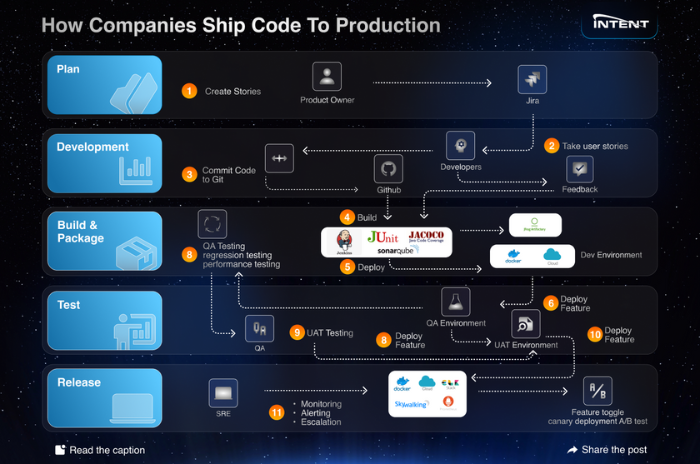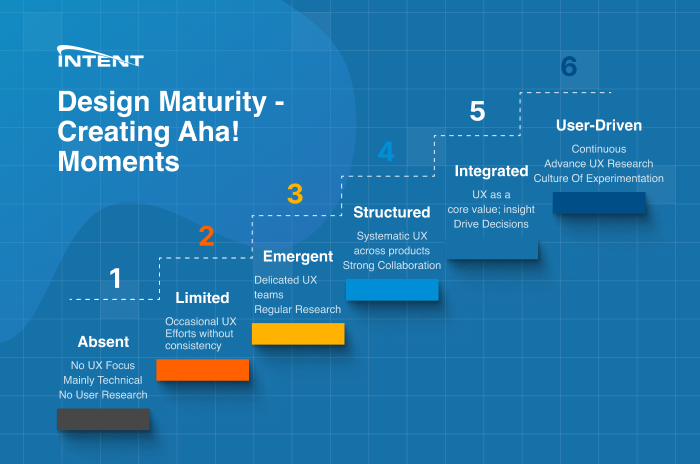How to Ship Code to Production: A Step-by-Step Guide

Shipping code to production is like completing a puzzle you've worked on for hours or days. It's the moment when your software, after all the development and team effort, is finally ready for the world to see and use. But this transition isn't just about assembling pieces; it involves strategic planning, thorough testing, and seamless teamwork.
This phase is crucial as it marks the code's transition from something only visible to the team to a well-functioning product used by many.
Consider the launch of a new restaurant: you've finalized the theme, prepared the menu, and trained the staff. The opening day for a restaurant is similar to deploying your code – it needs to operate flawlessly to make a great first impression. Like a restaurant undergoing inspections to ensure every aspect adheres to standards, your code must pass through its checks. These processes will confirm if all parts of your software work together effectively.
However, achieving this level of readiness takes time and effort. Observing code quality, managing dependencies within your software, and synchronizing all components can be complex. That's why a clear, step-by-step guide is crucial. Without it, the risk of encountering delays, last-minute problems, or launching a product that doesn't meet user expectations increases significantly.
This guide aims to navigate you through these challenges. It's designed to be your blueprint for a successful software launch. Let's ensure that your hard work translates into software that thrives in the real world.
Step 1: Creating User Stories
The initial step in the software development process is the product owner's creation of user stories. This stage involves converting the product requirements into specific, actionable tasks that guide the development team.
User stories are short, simple descriptions of a feature told from the perspective of the end-user or customer. They focus on the value or outcome the user will receive rather than detailing technical aspects, aligning the development efforts with user needs and expectations.
Best Practice
Engage in comprehensive discussions with all stakeholders, including potential users, to deeply understand their needs, preferences, and pain points.
These discussions uncover underlying needs that might not be immediately apparent. The insights gathered from these conversations are invaluable in crafting detailed user stories that are directly tied to user benefits.
Each story should follow a simple structure, typically:
"As a [type of user], I want [an action] so that [a benefit]."
This format focuses on the user's perspective and the intended outcome.
Step 2: Sprint Planning and Development
Following the creation of user stories, development teams proceed to sprint planning. In this phase, the team selects which stories to work on during the upcoming sprint—a fixed period, usually two weeks, dedicated to completing a set task list.
This step is pivotal in translating the outlined user stories into tangible features or improvements in the software product. The sprint format is a core component of agile development methodologies, promoting a disciplined, time-boxed approach to software development. It enables teams to have manageable chunks of tasks and deliver incremental value through a series of iterations.
Challenge
One of the significant challenges in sprint planning is finding the right balance between developing new features and addressing technical debt.
Technical debt refers to the extra development work that arises when code that is easy to implement in the short run is used instead of applying the best overall solution. Accumulating technical debt can decrease code quality and make future changes more difficult and time-consuming.
Solution
Teams need to prioritize tasks strategically. This involves identifying the most valuable user stories to deliver within the sprint and allocating time to:
- refactor code,
- improve existing features, and
- resolve bugs.
The product roadmap and the impact on the user experience should guide prioritization. Techniques such as weighted shortest job first (WSJF) or simply grouping tasks into categories like "must have," "should have," "could have," and "won't have" (MoSCoW) can help in making these decisions.
Step 3: Code Commitment and Version Control
At this stage, developers regularly commit their work to a version control system like GitHub. This practice is critical for managing changes and facilitating collaboration within the team.
Why It Matters
Frequent commits help identify which changes introduced issues, making it easier to resolve problems without sifting through a massive amount of code. Additionally, a platform like GitHub allows for peer reviews through pull requests, where team members can comment on and approve changes before merging into the main branch.
Overcoming Challenges
Merge conflicts and bugs are inevitable, especially in larger teams. Integrating a Continuous Integration (CI) system can automatically run tests and checks on new commits, catching errors early. Jenkins, for example, can be set up to trigger builds with every commit so that new code integrates well with the existing codebase.
Step 4: Automated Builds and Testing
After the code is committed, automated processes build the software and run tests. This automation is crucial for maintaining code quality so that new changes don't break existing functionality.
The Approach
Implementing a suite of tests, including unit, integration, and system tests, forms a safety net for the codebase. Tools like Jenkins automate these tests, running them against every new commit. Furthermore, setting quality gates with SonarQube ensures that the code progresses further in the development pipeline.
Addressing Common Issues
The challenge here often lies in maintaining the relevance and reliability of tests. Flaky tests, which sometimes fail and pass without code changes, can undermine confidence in the testing process. Regularly reviewing and updating the test suite is essential for keeping tests accurate and beneficial.
Step 5: Deployment to Development and QA Environments
Once the code passes automated tests, it's deployed to development and QA environments. This progression is pivotal for thorough testing and validation by the development team and QA professionals.
Streamlining Deployment
Automated deployment tools are indispensable at this phase. They help deploy software consistently across environments, reducing manual errors and speeding up the process.
Ensuring Consistency Across Environments
One hurdle is keeping the development, QA, and production environments identical. Discrepancies between these environments can lead to the dreaded "it works on my machine" syndrome, where bugs are difficult to replicate and fix. Adopting Infrastructure as Code (IaC) practices can mitigate this issue by using scripts to automate and standardize environment setups so that all environments are as similar as possible.
By focusing on these dynamic and relevant aspects at each step, development teams can create a more efficient and reliable workflow.
Step 6: Quality Assurance and User Acceptance Testing
Quality Assurance (QA) is a systematic process that ensures the product meets the established quality standards, including functionality, usability, and performance benchmarks. Following QA, User Acceptance Testing (UAT) is the final checkpoint, where actual software users test the software’s capability to handle required tasks in real-world scenarios according to specifications.
Elevating QA and UAT Practices
- Integrated QA and Development Efforts: A symbiotic relationship between QA professionals and developers can significantly enhance the efficiency of identifying and resolving issues. Incorporating QA insights early and throughout the development process helps catch bugs earlier and facilitates a smoother transition to UAT.
- Robust Testing Frameworks: Employ diverse testing methodologies, including automated regression tests, to catch backward compatibility issues and performance testing. Tailoring tests to mimic real-world usage scenarios closely can improve UAT outcomes.
Challenges and Solutions:
- Bug Tracking: The complexity of replicating bugs can stall the testing process. Implementing a comprehensive logging system and monitoring tools can help pinpoint the exact conditions under which a bug occurs, making fixes more straightforward.
Step 7: Production Deployment
The transition to production is a critical phase where the software becomes available to end users. Deploying controlled, such as through canary releases where changes are rolled out to a small subset of users, allows teams to monitor performance and gather feedback in a real-world environment before a full-scale launch.
Achieving Smooth Deployment:
- Incremental Rollouts: Gradually releasing the update to users can help mitigate risks. Monitoring these incremental rollouts closely allows teams to assess the impact and ensure the new changes do not adversely affect the user experience.
- Preparedness for Rollbacks: Despite thorough testing, unforeseen issues can arise. Having a well-defined rollback strategy enables quick reversion to a previous stable version if needed.
Addressing Deployment Challenges:
- Unexpected Issues: No amount of testing can replicate the infinite variability of the real world. Monitoring key performance indicators (KPIs) and user feedback post-deployment is crucial for quickly spotting and addressing any issues.
Step 8: Production Monitoring and Support
During post-deployment, the focus shifts to maintaining the application's stability and performance. Site Reliability Engineering (SRE) teams are pivotal in monitoring the application and addressing any issues that surface during its lifecycle in the production environment.
Best Practices for Ongoing Support:
- Comprehensive Monitoring Systems: Deploying a suite of monitoring and alerting tools provides real-time insights into the application's health and performance. This proactive stance helps identify and mitigate issues before they escalate.
- Incident Management: Establish clear protocols for incident response, including escalation paths and communication plans.
Overcoming Post-Deployment Problems:
- Rapid Issue Resolution: The dynamic nature of production environments requires a flexible and responsive approach to problem-solving. Leveraging detailed logs, real-time alerts, and automated recovery processes can help SRE teams address issues promptly, maintaining the reliability and performance users expect.
By adopting these detailed strategies, teams can successfully transition through QA, UAT, and production deployment. They can also maintain the highest application performance and user satisfaction levels in the live environment.
Making Code Deployment Easier with IntentSG
The path to deploying code to production is complex and laden with potential challenges that could derail even the most well-established software products. At IntentSG, we recognize the complexity of this journey and are dedicated to offering our expertise and support to simplify the process for software teams.
Our methodology is deeply rooted in the principle of collaboration. By combining our global expertise with hands-on experience, we deliver clear, actionable strategies tailored to your specific needs.
Our objective is to become an extension of your organization, boosting your product's progress while steadfastly maintaining high-quality standards. This collaborative approach is designed to overcome immediate hurdles and lay a robust foundation for your product’s long-term success.
Working with IntentSG means partnering with a genuinely invested team in your growth and success within the ever-evolving software development arena. We commit to providing the guidance and support necessary to navigate the complexities of code deployment, transforming challenges into opportunities for innovation and excellence.




